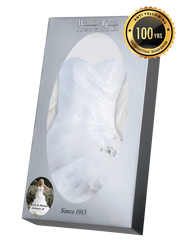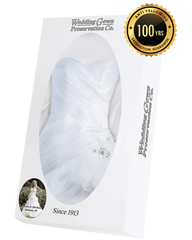Wedding dress preservation is a magical way to keep your special memories alive for years to come. It is a unique way to encapsulate the memories of your special day and keep them for a lifetime. Whether you want to preserve your wedding dress for yourself or you want it to be passed down to the next generation, the process of wedding dress preservation is the perfect way to do so. With the proper techniques and materials, you can keep the beauty and quality of your wedding dress intact for years, even decades. This definitive guide to wedding dress preservation will provide tips and tricks to ensure your dress is preserved in the best possible way. So grab your wedding dress, and get ready to protect your special memories!
What is wedding dress preservation?
Wedding dress preservation is the process of removing pollutants and pollutants from your wedding dress and then storing it in a controlled environment. This way, it can be preserved for many years or even decades so that multiple generations can enjoy it. Wedding dress preservation can be done in different ways, with some methods being more accessible and less expensive than others. The most popular types of preservation include framing, encasing, bagging, and interring your wedding dress. Simply storing your wedding dress in the attic or closet is not considered preservation, as it doesn’t protect it from the elements. Wedding dress preservation protects your clothing from insects, pests, and humidity, so it is always safe to enjoy and look at. It also prevents your dress from yellowing and fading over time.
Benefits of wedding dress preservation
There are many benefits to wedding dress preservation. First, you can safely and efficiently store your dress without worrying about its condition. You can preserve your gown for years or even decades, which is excellent if you plan to hand it down to future generations. Wedding dress preservation also holds the memories of your special day. If you want to keep your dress on display, you can use it as a decoration that will continuously remind you of your special memories. You can also use your preserved dress in photo albums, scrapbooks, and other mementos. Keeping your clothing will also help avoid potential pests and other problems damaging your wedding dress.
What are the different types of wedding dress preservation?

There are four main types of wedding dress preservation: framing, encasing, bagging, and interring. Each of these conservation methods has its pros and cons, so you can decide which is best for your wedding dress based on your situation. Framing is the most common way to preserve your wedding dress. It is a simple process where your clothing is attached to a wooden frame with a special resin. The resin is then allowed to dry and harden so the frame is sturdy and the dress can be removed. The frame can then be painted or decorated with fabric so it is always visible and doesn’t take up too much space. Encasing is similar to framing, but your wedding dress is placed inside a bag or container before it is sealed. This way, it is protected from insects and other potential pests, but you can still view the dress quickly. You can also embellish the encasing with decorations to match your wedding theme. Bagging is the simplest and easiest way to preserve your wedding dress, but it may not offer adequate protection against pests if you live in a humid environment. Bagging involves wrapping your dress in a particular type of paper and storing it in an airtight container. If you decide to bag your dress, keep it in a cool, dry place. Interring is more expensive but provides the best protection against humidity and pests. Your dress is placed inside a wooden box, and then a particular type of concrete is poured around it to seal it. This type of preservation is often used for fragile fabrics or vintage dresses that require special care.
Preparing your wedding dress for preservation
Before you decide on a method of wedding dress preservation and start sealing it away, you must ensure it is clean and free of dirt and other pollutants. You can use a garment cleaner to remove any stains and odors, then brush out the dress to remove dust and fibers that may have accumulated over the years. You can also dry clean your dress to make sure all the pollutants are removed. All of these steps are necessary to protect your clothing and allow it to be preserved safely and effectively. When you are ready to protect your dress, be sure the fabric is clean and ironed before you start. You can even put a clean cloth behind the dress to protect the table or surface you are working on.
Selecting the best wedding dress preservation method
You should select the best wedding dress preservation method based on your budget and the condition of your dress. If your dress is old and fragile, you should use the more expensive interring form, as it will provide more protection. You can use framing or encasing if you want a more decorative option. If you have a lot of money to spend, you can have your dress professionally preserved, but you can also do it at home if you have the proper equipment and know-how. No matter which method you go with, always ensure the materials used in the preservation process are non-toxic and safe for your wedding dress. The last thing you want to do is damage your clothing even further by using incorrect materials!
Tips for storing and displaying your preserved wedding dress

Once you have your preserved wedding dress, you need to figure out how to store it properly, so it stays safe and undamaged. You should keep your preserved dress in a cool, dry place without direct sunlight. You can also use an anti-fungal spray to prevent mold and mildew from forming. If you want to display your preserved dress, use an acid-free stand, so it doesn’t get damaged. You can also use a particular fabric to wrap your dress if you want to keep it protected. Using your preserved dress as a decoration, you can attach it to a wall using hooks or nails. You can also create a shadowbox frame or something similar to display your preserved dress on a wall. You can also use your preserved dress in scrapbooks, photo albums, or other mementos.
Steps for safely cleaning and caring for your preserved wedding dress
Once you have preserved your wedding dress, you must ensure it stays clean and safe for long-term storage. You can use a soft, clean cloth to dust off your preserved dress and be sure never to use water or harsh chemicals on your clothing. If your preserved dress gets damaged or stained, you can use a particular type of stain remover on the area, but do not put water on it! If your preserved dress needs to be washed, you should do so by hand with a gentle detergent. You should never put your preserved wedding dress in the dryer because the heat will damage the fabric. You can air-dry your clothing or use a clean towel to remove the moisture. Make sure you hang your preserved dress on a clean, non-rusting hanger when you are finished. You can also place it in a neat storage bag to protect it from dust and other pollutants.
Common mistakes to avoid when preserving your wedding dress
Before you start preserving your dress, be sure to avoid these common mistakes. First, ensure you select the best method of preservation for your wedding dress. Don’t just go with the cheapest or the way you think looks the prettiest. Ensure your clothing is preserved correctly so it lasts for years to come! Also, don’t cut corners when cleaning your dress before preservation. Make sure it is clean, free of pollutants, and ironed adequately before you start any preservation methods. Another common mistake is not storing your preserved dress in the correct environment. Your clothing needs to be in a clean, dry place without direct sunlight. Keep your preserved dress in a clean bag or container to protect it from dust and other pollutants.
Wedding dress preservation services
If you don’t have the time, patience, or know-how to preserve your wedding dress, you can always hire a wedding dress preservation company. These companies specialize in keeping wedding dresses and other delicate fabrics.












 200 Business Park, Freehold, NJ 07728
200 Business Park, Freehold, NJ 07728
 (866) 308-8822
(866) 308-8822 info@trustedweddinggownpreservation.com
info@trustedweddinggownpreservation.com